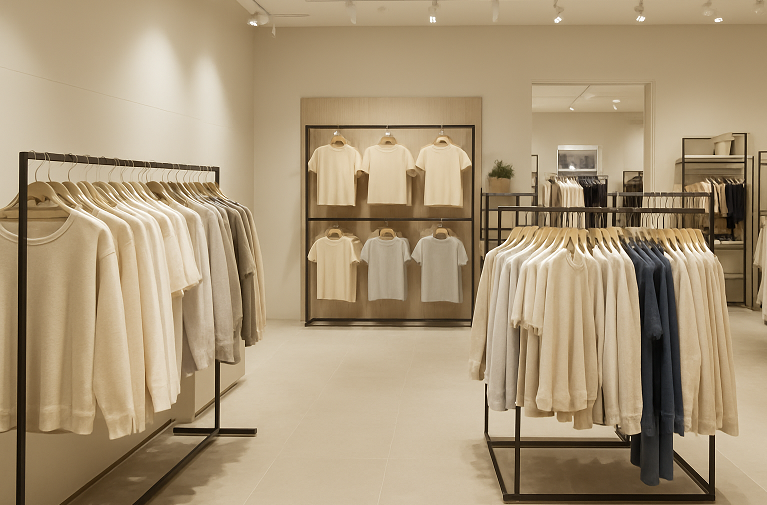
Last weekend, I wandered through a downtown mall that used to be bustling with shoppers. This time, it felt unusually quiet. Stores ranged from fast-fashion chains to premium and luxury labels, yet only a few people were browsing.
As I passed the racks, something struck me: so many clothes looked almost the same. Neutral sweaters, simple jeans, and basic shirts filled the shelves in endless repetition. Even new autumn collections failed to catch attention, while many shoppers headed straight for clearance racks.
At one point, I overheard a customer ask, “Why is this T-shirt five times more expensive than that one? They look identical.” Curious, I picked both up to compare. Both were labeled as 100 percent cotton. The pricier one had a combed, smoother yarn and a slightly heavier fabric, while the cheaper one felt lighter and rougher. With years of experience in this field, I could notice the difference immediately, yet for most shoppers, the two would probably feel nearly the same.
That moment reflected a larger truth: many collections today lack distinction. Once, certain brands were known for bold cuts, unique silhouettes, or intricate tailoring. Their designs stood out, often defining entire eras of style. Now, much of what we see feels interchangeable, with only subtle differences in fabrics, finishes, or prints.
Consumers notice this shift. According to two online surveys of around 4,100 U.S. adults conducted in 2024 by The Harris Poll for a leading online retailer, price and quality remain the most important factors. Yet nearly seven in ten respondents also said they value clothing that reflects their individual style. Even when shopping for basics, people are drawn to garments that feel personal.
Fashion, at its best, is not only about utility. It is art, imagination, and a way of expressing identity. As Yves Saint Laurent once said: “Fashions fade, style is eternal.” This reminder captures what is at stake today.
This sameness in design is emerging just as the garment industry faces major global shifts. According to WTO statistics, Asia accounted for more than 65 percent of global clothing exports in 2024. New U.S. tariffs on textiles and apparel, introduced in mid-2025, are already pushing brands to rethink their sourcing strategies.
Western Europe once had thriving garment industries. Countries such as Italy, Spain, France, and the UK built reputations on craftsmanship and creativity. Eastern Europe, including Romania, Bulgaria, and Poland, developed into significant production hubs for international brands, benefiting from proximity and skilled labor. Turkey, with its long-established textile sector and customs union with the EU, continues to play an important role.
At the same time, China’s position remains central. Beyond being the world’s largest apparel exporter, it offers innovative raw materials, advanced textile machinery, and a wide range of sewing equipment. Even as tariffs affect exports to the U.S., China is likely to remain highly competitive in supplying fashionable products to European markets and other regions not impacted by these restrictions.
While large-scale production is still cheaper in Asia, nearshoring is being reconsidered not only for speed but also for sustainability. Shorter supply chains can reduce transport emissions, while regional hubs often operate under stricter labor and environmental standards. In Europe, this shift has particular importance: luxury and premium products are already manufactured largely within the region, and they are likely to remain there, preserving craftsmanship while meeting growing expectations for traceability and responsibility.
The future of production may be a blend of approaches: global scale where cost matters most, and regional hubs where creativity, sustainability, and speed are essential.
Efficiency is vital. No company can survive without improving speed, cost, and delivery. Yet efficiency without imagination reduces fashion to mere basics, and risks disengaging consumers.
The Harris Poll surveys underline this tension. Shoppers care about price and quality, but they also seek individuality in what they wear. When store racks are filled with garments that look alike, differences between labels fade, and shoppers leave uninspired.
The challenge for brands is to remain competitive while still nurturing the artistry that makes clothing more than just fabric and stitching.
Walking through that quiet mall was a reminder of the balance fashion must strike. Shoppers are not only searching for another T-shirt or sweater. They are looking for something with personality, a touch of creativity, and a reason to feel inspired.
Looking ahead, the industry’s future will depend on balancing efficiency with creativity and sustainability. Trade policies and tariffs may shift parts of production closer to Western markets, yet Asia’s role as the largest and most cost-effective hub will remain significant. Regions such as China, Turkey, and Eastern Europe will continue shaping supply chains in different ways.
When fashion succeeds, it delivers more than garments. It creates a spark that connects with identity, style, and imagination. That spark will determine whether the industry continues down a path of quiet sameness or moves toward vibrant renewal.
← Back to homepage